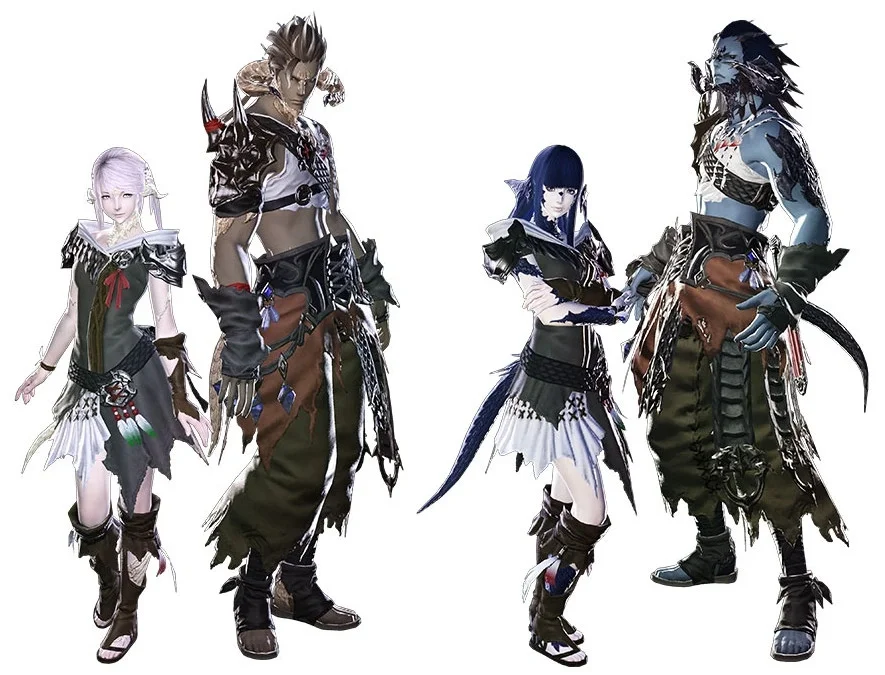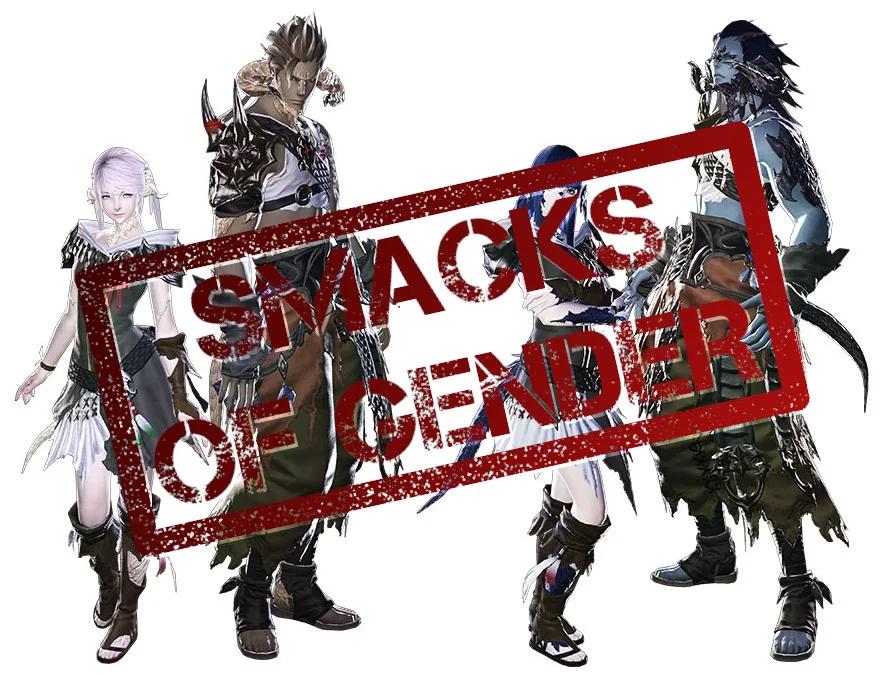These are written about in a really dumb way, ain’t they?

If you’re not familiar, the Au Ra are a playable race option from the award winning massive multiplayer online roleplaying game Final Fantasy XIV, which says a lot more about the level of quality that earns you awards in that particular space. You can summarise them in a bunch of ways, like, how they’re kind-of-dragony people (but lore-wise, definitely not dragons), they’re Mongolian-ish people (but lore-wise, they’re totally cool with Japan coming in and helping them run their country, which, uh), and they’re monstrous (but in their lore definitely not monsters).
But we’re below the fold, there’s no need for me to dance around this.
Look, Au Ra are there to bait dragonfuckers.
No kidding, no dancing around it, characters in Final Fantasy XIV are made to be hot and because they make particular developers horny, I’m pretty confident of that, and with that lens, Hrothgar are there for gay bara furries, Roegadyn are for people who want to be stepped on by a giant woman, and the Au Ra are there to hit two important kinks at the same time: Dragonfuckery and size differences.
The default Au Ra, as presented in the game, are the two most dimorphic races in the game. The tallest Au Ra woman can cap at a height of 157 cm, and the shortest Au Ra man sits at a height of 200 cm – and again, that’s the tallest woman compared to the shortest man. In this race’s case, the genders are starkly binarised. Au Ra women are also extremely delicate and cute, while Au Ra men are scaled and needlessly edgy, with horns and sharp teeth and glowery eyes. They are a giant edgy boy and a petite loligoth girl and that’s it, that’s your strict binary.
And look there’s nothing in the world saying that your character has to resemble the way they’re represented in the game — after all, I play an Au Ra, and I don’t accept the height the game tells me he has. I imagine he’s even taller. If you want to play an Au Ra that’s six feet tall and a woman I personally think that I should be okay with that. The thing is the game’s affordances and character building options don’t put that in front of most people – and people will typically look at the tools presented to them to readily create their characters. Basically, by showing you ‘this is the range these characters can be in’ most people are going to assume those are the ranges.
People will also get that wrong.
See, if you give a player a set of things that correctly capture the way they feel, it doesn’t matter the technical values per se, it matters how they feel. People will often give ballparks of how big their characters are, even if the scale presents weird questions, because people aren’t even good at measuring how humans interact across our scales.
This strict binary, though, also ties into the lore around the Xaela (the dark-skinned Mongolian-a-like Au Ra), who, the lore says, are divided into a wide number of clans that roam across the regions of the Azem Steppes, with a variety of different cultural traditions. These traditions can be interesting background material for player characters, like the Ejinn, who are river hunters and learn to hold their breath a long time, or the Ura, who are the only Xaela who have mines.
They can be more primary, shaping the way your character looks at the world. The Mol, for example, are mystics and see their culture in terms of religious experience. The Dotharl think they’re immortal and reincarnate, meaning they attack literally everything. The Qestir refuse to talk, and, oh boy, I bet that’s annoying in roleplay!
And then there’s the point where things get really weird. A number of the Xaela clans — of which mostly, we have only a single-sentence summary! — are defined by something that’s very genders. The Bayaqud practice polyandry, the Borlaaq kill their male youths and breed with outsiders, the Buduga are all male and reproduce through kidnapping, the Dazkar segregate roles by gender, with only the women being allowed to hunt, Goro heterosexually marry horses, the Iriq are an all-male tribe that picks up the abandeond males of the Borlaaq, and the Olkund have even larger males than normal.
Oh and these aren’t queerness, but to also talk about the way these clans get described, there’s also the Bairon (piss drinkers) and Bolir (poop collectors), the Horo (inflation practitioners), and at least three tribes who are defined by ‘we don’t know shit about them and they avoid everyone,’ which is kind of cheating as far as a cultural identity, especially if you do it three times, and three tribes that are ‘secretly hiding in other tribes’ like the Xaela have their own myths about Jewish people, two tribes whose special trait is ‘they communicate over long distances musically.’
This can be a bit awkward to grapple with as a queer roleplayer in this space, because for these cultural groups, that are largely interesting and cool, the way that some clans are described as being specifically different or gendered, means that there’s an implication that they’re the exception. Like polyandrous women seem rare when one clan is specifically described as doing it. Between the grotesque dimorphism and the extremely gendered descriptions of these cultures, it’s kinda hard to feel that this is, as so often the case, some Het Nonsense.

What I’d like to present is a much more reasonable take, based on the textual information we have about these cultures, and that is: They’re wrong.
Or, to be more clear: These single sentence summaries are written as a coloniser examining an indigenous culture, meaning that all information is filtered through that coloniser’s biases and their convenience. Some of these facts, especially the ones that are really easy and obvious, are probably true. The Bolir probably do gather up dung and use it – because that’s a practice you’re likely to see someone doing, and it gels with existing practices we know of people. On the other hand, do the Bairon actually drink all their bodily fluids, all the time?
Probably not?
Like they describe it as a thing they do to survive in the most remote parts of the largest desert, in a setting where people can and do magically create water and teleport, a thing that people in this culture are shown doing. What’s the practical answer here: Are the culture as a whole going to venture in the desert by drinking their piss, or are they going to venture in the desert by We’re not fucking telling you, and then tell the pith-helmeted Hyur researcher an entertaining lie to see if he’s dumb enough to write it down?
We’re getting to gender, I promise you.
This means that the practices need to be grounded in something, they need to make some sense — but the actual outcomes and reasons are going to be wildly different. How sustainable is a microculture culture that steals children as their only way to persist? Against a culture of extremely warlike dangerous dragon people? These clans go to war with everyone in full goblin mode once a Naadam, you only need one big ‘Everyone Has A Fight’ fight for the Buduga clan as described to get completely exterminated.
Plus do you imagine going to the Buduga clan and saying ‘hey hi, what do you people do?’ when three of the clans in the lineup are already mentioned as ‘they didn’t talk to me and I have no idea what they’re like?’ The Buduga clan might not even exist. It might be a surname that the Raen use like Alan Smithee, oh yeah, my name is Ish Buduga, officer.
That means that all the ‘lore’ we have for these cultures is inherently suspect, and then you can only operate on what you can do in that space. Sure, the designers only let you have towering masc Au Ra and tiny petite femme Au Ra, but they’re also cowards who told us that an entire tribe drinks their own piss all the time. That sounds dumb as hell.
Then we can look, in game, and see the Dotharl. The Dotharl are in fact, not randomly homicidal, though they are absolutely spoiling for a fight as a group. They don’t fear death, because they tell stories of reincarnation, but you notice what else they have there? They have a recognition that gender and bodies are not the same thing. There’s a Dotharl who’s a reincarnation of a recently deceased mighty warrior – except the genders of the two don’t line up. That means that everything else being agnostic, there’s a dimension of the culture that indicates that at least they don’t see the genders of bodies and the identities of people being concretely aligned. And that’s often all you need to get involved in these complex conversations about how cultures see and talk about identities.
Consider a culture where everyone is, by our cultural view, trans. How would you tell? How would you know, if they didn’t tell you that? When would they tell you that? What would telling you entail? We don’t tend to describe air after all. If an outsider culture assigns genders to kids and then enforces them, and yours doesn’t, you could go a long time without ever finding out that’s a thing, and it’s the outsiders who are being weird, from where you sit.
The question should always be: Who is telling you this, and then following that, What would need to be true for that to make sense?
That’s something, in academia, we refer to as provenance – the origin or earliest appearance of something. If you use a term, knowing where it came from can be invaluable, especially for understanding how that use has changed over time, and meanings you may not mean to smuggle along with what you said.
Basically, Au Ra have every reason to be queer as fuck, gender nonconforming as fuck, and the fact that there’s a trend towards a binary doesn’t mean that binary is a real thing that reality enforces.
Fuck’s sake, the Warrior of Light is meant to be reincarnated, how real can gender even be.